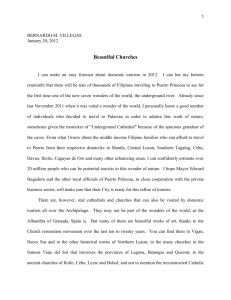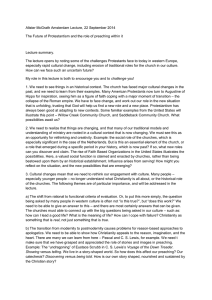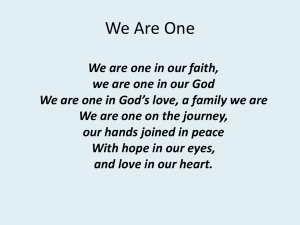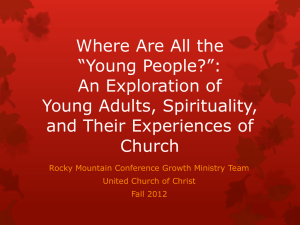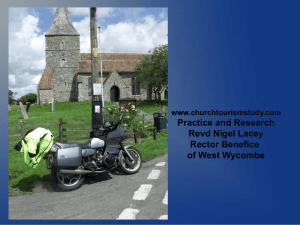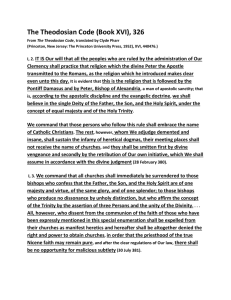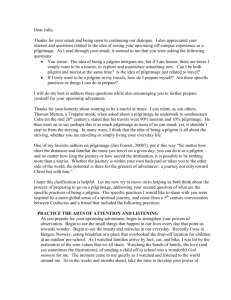A sermon preached by the Rev`d Canon Dr
advertisement
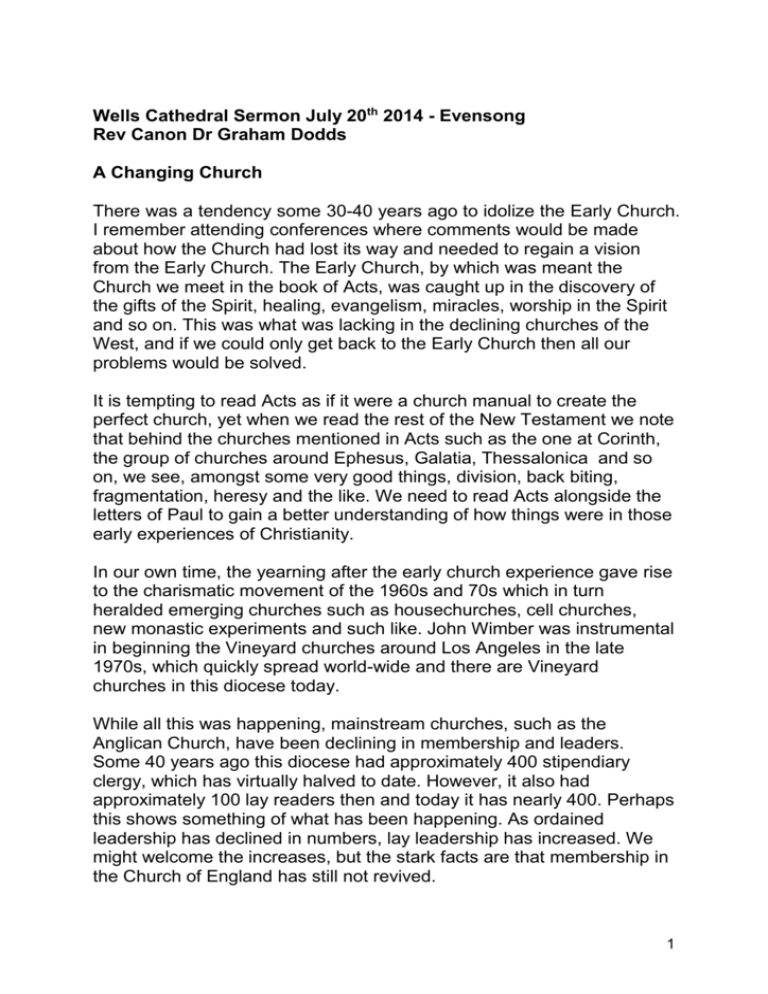
Wells Cathedral Sermon July 20th 2014 - Evensong Rev Canon Dr Graham Dodds A Changing Church There was a tendency some 30-40 years ago to idolize the Early Church. I remember attending conferences where comments would be made about how the Church had lost its way and needed to regain a vision from the Early Church. The Early Church, by which was meant the Church we meet in the book of Acts, was caught up in the discovery of the gifts of the Spirit, healing, evangelism, miracles, worship in the Spirit and so on. This was what was lacking in the declining churches of the West, and if we could only get back to the Early Church then all our problems would be solved. It is tempting to read Acts as if it were a church manual to create the perfect church, yet when we read the rest of the New Testament we note that behind the churches mentioned in Acts such as the one at Corinth, the group of churches around Ephesus, Galatia, Thessalonica and so on, we see, amongst some very good things, division, back biting, fragmentation, heresy and the like. We need to read Acts alongside the letters of Paul to gain a better understanding of how things were in those early experiences of Christianity. In our own time, the yearning after the early church experience gave rise to the charismatic movement of the 1960s and 70s which in turn heralded emerging churches such as housechurches, cell churches, new monastic experiments and such like. John Wimber was instrumental in beginning the Vineyard churches around Los Angeles in the late 1970s, which quickly spread world-wide and there are Vineyard churches in this diocese today. While all this was happening, mainstream churches, such as the Anglican Church, have been declining in membership and leaders. Some 40 years ago this diocese had approximately 400 stipendiary clergy, which has virtually halved to date. However, it also had approximately 100 lay readers then and today it has nearly 400. Perhaps this shows something of what has been happening. As ordained leadership has declined in numbers, lay leadership has increased. We might welcome the increases, but the stark facts are that membership in the Church of England has still not revived. 1 I was at a lecture recently by the distinguished Scottish social historian, Professor Callum Brown. Professor Brown wrote a controversial book in 2001 entitled The Death of Christian Britain. In it, he attempts to prove from statistics and in depth interviews that this ‘death’ began in the swinging 60s and has resulted in catastrophic decline of church membership. Not only is this detrimental to the Church’s wellbeing, it is also disruptive for the nation, as attitudes based on Christian values held in the 19th and early 20th centuries, seen in, for example, tracts, magazines, novels and obituaries, are now lost, and morality and our social mores are like a ship without a rudder. Brown’s critique was, and still is controversial and somewhat shocking. However his work is, in my opinion, well researched and needs careful examination. For example, in 1960 there were 190,000 confirmations, by 1997 just 37 years later this was reduced to 40,000 – the biggest drop occurring between 1960 and 1970. The same is true of baptisms, attendance at Sunday School, marriages solemnised in church and communicants – all have dropped considerably in the period between 1954 and 2010. The lecture I attended gave an opportunity to think further. Professor Brown was followed by some responses to his lecture. One in particular came from a Pentecostal minister who asked, ‘What is actually being measured here?’ His argument was that true faith should not, perhaps even cannot, be measured in church attendances. This was somewhat provoked by Professor Brown’s use of interviews of people who spoke of seemingly losing their faith. The professor played an interview of a soldier in the Second World War who had seen horrendous death and had seemingly given up on God. The Pentecostal minister asked about what faith he had in the first place. It was similar in the other examples Callum Brown offered and it made me wonder about how we define faith and the faithful. For example, when a person regularly attends church we tend to assume they are part of the faithful. When we hear someone outside church profess something of the tenets of Christianity we tend to assume they are also part of the faithful. But would we also say that someone who simply asks questions about Christianity is part of the 2 faithful as well? They are certainly seekers. And what about all the tourists who come to the Cathedral and simply look and wonder, and muse and contemplate? Are they on the journey of faith? Statistics about the Anglican Church show large-scale decline, but are we seeing real decline or a change in the way people want to assimilate religion? In one sense Professor Brown presents a rather depressing picture, however, in another sense he may be pointing us towards a change in how people believe in the 21st century. Regular attendance in church, has declined, however, what may be emerging is a different form of religious adherence. This different form is not centred on weekly or even monthly attendance at a service. In fact it is difficult to measure at all for it is often quite itinerant. Choices are made about what kind of religious experiences are helpful – sometimes these are individually helpful – a quiet space in a sacred building where a weary soul can find some rest, an opportunity to explore a challenge or a problem or a regret, or perhaps the experience of walking a labyrinth of prayer. Sometimes they are corporate experiences - learning through seminars, social media and web experiences, annual gatherings such as New Wine, Spring Harvest, Taize, or indeed pilgrimages to a local Cathedral. So when Archbishop Rowan Williams pointed out in the 2004 reportMission Shaped Church that these new forms of church should be scrutinised to assess whether we can really call them church, it’s not very easy because these sorts of experience often happen quietly, behind the scenes, and are not easily described. And that forms an interesting question as to what constitutes God’s church as opposed to any other form of organisation. One of the encouraging things that has begun to happen is that while all sorts of experiments have been started over the last 10 years, over recent months some data about what is happening has been published. From Anecdote to Evidence was published earlier this year, Spiritual Capital, the Cathedral’s report was published in 2012, the Church of England has produced statistics about each parish, available on diocesan websites called Parish Spotlights, and our own market research has been conducted in the Cathedral – and indeed Chapter will be looking at some of this data tomorrow. One way of looking at this data, and indeed the Church, is through the metaphors it adopts and a major metaphor for emerging churches is 3 journey – thinking of faith and indeed life as a journey or pilgrimage from birth to death and beyond. The use of pilgrimage in the Church is as old as the hills. The Psalms of Assent bear witness to its use in the OT, and historical documents show how important it was to the Early Church. A pilgrimage is traditionally a group of people, in fact of any faith, who travel together to a place. In terms of Christian pilgrimage and according to a Stockholm University study in 2011, and I quote: Pilgrims visit the Holy Land to touch and see physical manifestations of their faith, confirm their beliefs in the holy context with collective excitation and connect personally. The number of pilgrimages has risen in the 21st century so that the top 39 places of pilgrimage including Rome, the Holy Land and Compostella in Spain receive some 200 million pilgrims each year. What I find interesting in the phenomenon of pilgrimage is that it suggests that people want faith to be tangible and dynamic. The faithful want to go places, see, hear and touch things, chat to people on the way, get excited, connect personally and so on - and this raises a question of how the Church can be a movement not just an institution. There’s much discussion about the movement vs institution debate and the increased interest in pilgrimage takes us to the heart of it. Can the institutional Church find a way through its institutionalism to allow the journey of faith to prevail? Brown was measuring institutional Church, and clearly it is in decline. However, we may now be glimpsing a different picture of emerging churches. People reconstructing faith, less like a group we belong to, and more like a journey we might join - hence the rise in numbers at occasional and weekday oases of peace, like traditional Anglican evensong and candlelight services, Easter vigils, a requiem on Remembrance day afternoons - people choosing what will help them spiritually as they walk the way. Evidence seems to suggest that people like the notion of going on a journey, possibly especially if they don’t know quite where the end is. On the way they want to see, hear, touch, smell and taste things. They want to find out about the history and the significance of things and interpret 4 these experiences for themselves - not have meanings imposed from some institutional hierarchy. If we are canny, if we want to help these pilgrims, if we want to share the glorious gospel of a loving, wise and generous God who has riches to share with us, then, as parish churches and cathedrals, we need to understand much more about what it means to be a movement. At its best, institution brings order, organisation, identity and security. At its best, movement brings dynamism, innovation, trust and risk. The Church needs both, and God’s challenge to us here in the second decade of the 21st century is to employ the Wisdom of Solomon and the boldness, courage and tenacity of the early disciples to continue the building of God’s Church and God’s Kingdom. 5
